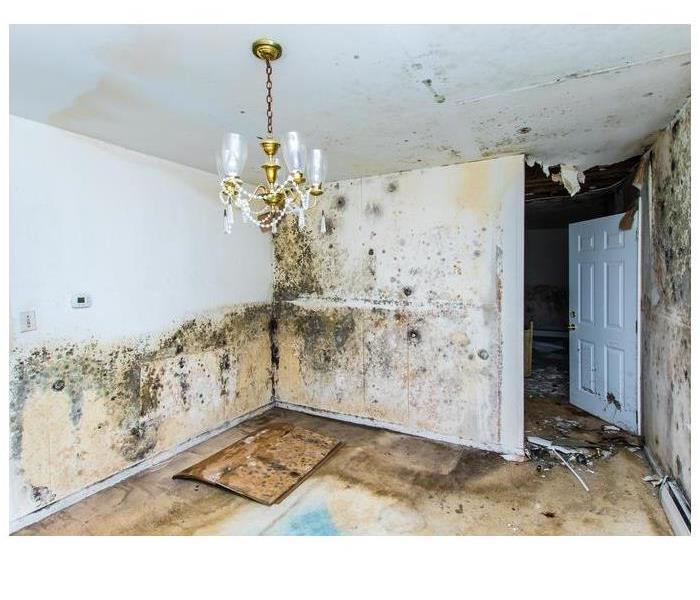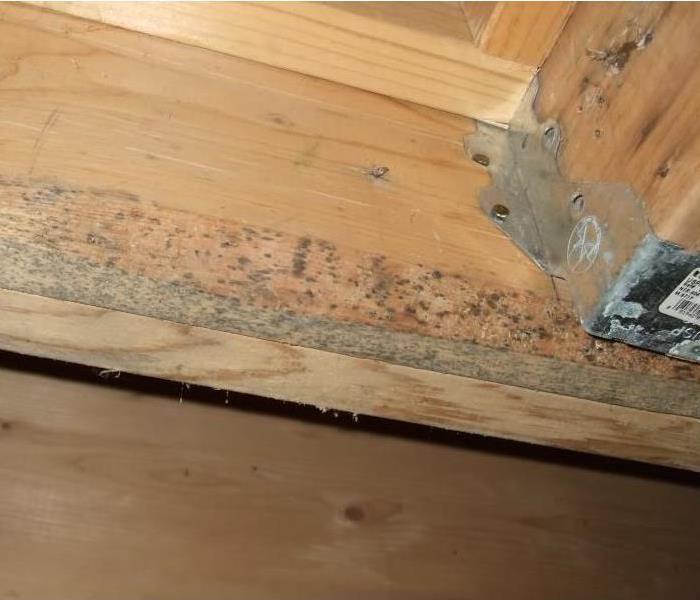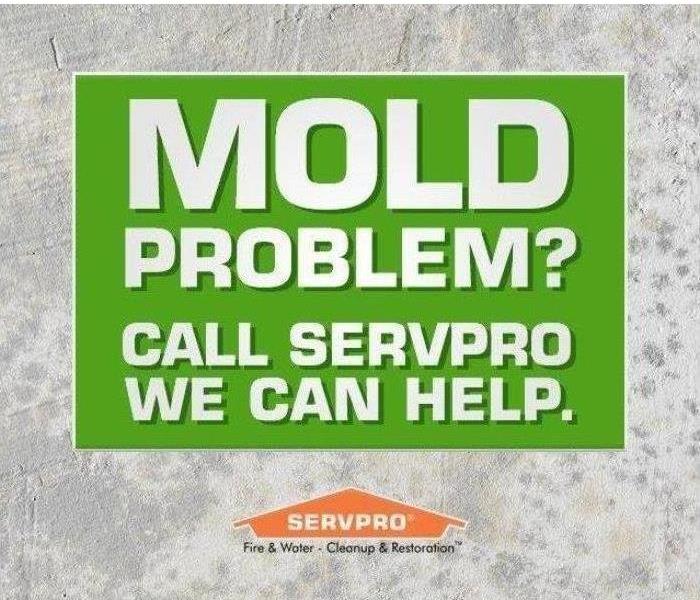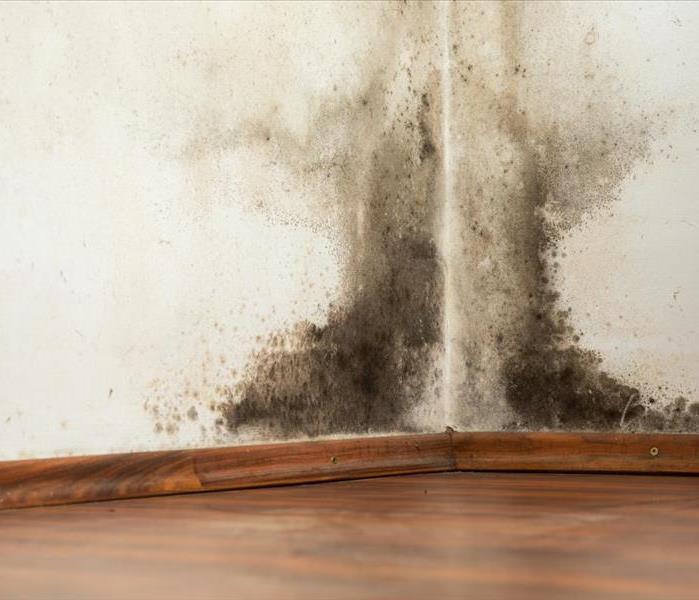Recent Mold Remediation Posts
What to Expect from a Mold Remediation Company, Like SERVPRO
9/21/2019 (Permalink)
We recently published a blog post about water damage and what the Chicagoland Best Pick Reports said one should expect from a company that provides services dealing with water damage. They also talk about mold remediation and the practices that good remediation companies use in that same article, which are practices that SERVPRO of Norridge/Harwood Heights is proud to use.
Mold Remediation
If water damage isn't handled in a timely manner, mold can grow, causing a larger problem. A reputable company should isolate any moldy areas in order to prevent the spores from spreading. Mold causes health problems, which is why it's important that mold doesn't spread and negatively affect your or your loved one's health. Any professional that enters these spaces will use the proper protective equipment. Until you receive confirmation that the mold has been removed, stay out of any contaminated areas as well.
SERVPRO of Norridge/Harwood Heights is certified to handle any mold issues you may encounter.
What To Do If You Smell Mold
6/3/2019 (Permalink)
 Experts say there are over 100,000 types of mold
Experts say there are over 100,000 types of mold
If you have identified a mold smell in your business or home in Norridge/Harwood Heights then further action on your part is required. While mold can sometimes be difficult to find with a visual inspection, you may actually be able to smell mold in your residence.
Why Mold Smells
Mold isn't a pleasant odor, but what exactly is it that makes mold smell the way it does? The odors caused by mold are caused by chemicals called Microbial Volatile Organic Compounds (MVOCs) that are released as mold grows. Depending on the type of mold in your residence or business, you may experience any of the following smells that mold can be the cause of:
- Musty or earthy
- Oil or Grease
- Cat Urine
- Dirty Socks
- Mowed Grass
- Locker Room
- Alcohol
Where Mold Hides
Mold doesn't have to be seen to exist, which is why it's important to take these smells seriously. If undetected moisture builds up in your residence or business, mold can grow and cause damage to the building. Common mold hiding spots in your commercial building include:
- Carpet Padding
- Ceiling Tiles
- Drip Pans
- Wallpaper
- HVAC systems
What To Do About a Mold Smell
Once mold is suspected through an odor, contact a mold remediation expert like SERVPRO of Norridge/Harwood Heights. These experts know the areas to search for mold and have the right equipment like infrared cameras that can show moisture in a building's structure.
When you suspect there might be mold growth in your commercial building or home due to complaints of a mold smell, it is important you act quickly. This will be prevent the mold from spreading to other parts of your building or home.
All About Mold
5/14/2019 (Permalink)
With the recent rains we have experienced in Norridge/Harwood Heights, it's important to know what to do if you find mold in your house and the danger it could cause to your family.
If you have had recent water damage, it's important to know that mold could be growing within walls, so even if there is none on the outside, it's still important that you have a professional, like SERVPRO of Norridge/Harwood Heights do an inspection.
If you do find mold on the outside of a wall, you may be tempted to clean it yourself, but most people who attempt to clean up the mold by themselves do not get it all. It might also be necessary to remove drywall, floors, and carpet if the mold has grown extensive.
Mold in the house can be a major allergen, causing breathing problems and skin irritations. It could also destroy building materials in your house.
If you are experiencing mold in your home, call SERVPRO of Norrdige/Harwood Heights to remove it professionally in order to keep your house safe.
Mold Prevention Tips
4/17/2018 (Permalink)
- Keep humidity levels as low as you can—no higher than 50%–all day long. An air conditioner or dehumidifier will help you keep the level low. Bear in mind that humidity levels change over the course of a day with changes in the moisture in the air and the air temperature, so you will need to check the humidity levels more than once a day.
- Be sure your home has enough ventilation. Use exhaust fans which vent outside your home in the kitchen and bathroom. Make sure your clothes dryer vents outside your home.
- Fix any leaks in your home’s roof, walls, or plumbing so mold does not have moisture to grow.
- Clean up and dry out your home thoroughly and quickly (within 24–48 hours) after flooding.
- Add mold inhibitors to paints before painting.
- Clean bathrooms with mold-killing products.
- Remove or replace carpets and upholstery that have been soaked and cannot be dried promptly. Consider not using carpet in rooms or areas like bathrooms or basements that may have a lot of moisture
Mold Clean up Tips
4/17/2018 (Permalink)
The tips and techniques presented in this section will help you clean up your mold problem. Professional cleaners or remediators may use methods not covered in this publication. Please note that mold may cause staining and cosmetic damage. It may not be possible to clean an item so that its original appearance is restored
Fix plumbing leaks and other water problems as soon as possible. Dry all items completely. ¦ Scrub mold off hard surfaces with detergent and water, and dry completely.
If you suspect that your home or business has a mold problem, SERVPRO of Norridge/Harwood Hts. Franchise Professionals can inspect and assess your property. If mold is found, SERVPRO of Norridge/Harwood Hts. has the training, equipment, and expertise to handle the situation.
Hidden Mold
2/13/2018 (Permalink)
 Mold on Framing
Mold on Framing
Suspicion of hidden mold
You may suspect hidden mold if a building smells moldy, but you cannot see the source, or if you know there has been water damage and residents are reporting health problems. Mold may be hidden in places such as the back side of dry wall, wallpaper, or paneling, the top side of ceiling tiles, the underside of carpets and pads, etc. Other possible locations of hidden mold include areas inside walls around pipes (with leaking or condensing pipes), the surface of walls behind furniture (where condensation forms), inside ductwork, and in roof materials above ceiling tiles (due to roof leaks or insufficient insulation).
Investigating hidden mold problems
Investigating hidden mold problems may be difficult and will require caution when the investigation involves disturbing potential sites of mold growth. For example, removal of wallpaper can lead to a massive release of spores if there is mold growing on the underside of the paper. If you believe that you may have a hidden mold problem call SERVPRO of Norridge/Harwood Ht. to inspect.
Mold Remediation in Schools and Commercial Buildings
12/5/2017 (Permalink)
Concern about indoor exposure to mold has been increasing as the public becomes aware that exposure to mold can cause a variety of health effects. This document presents guidelines for the remediation/cleanup of mold and moisture problems in schools and commercial buildings; these guidelines include measures designed to protect the health of building occupants and remediators. It has been designed primarily for:
- Building managers
- Custodians
- Others who are responsible for commercial building and school maintenance
It should serve as a reference for potential mold and moisture remediators. Using this document, individuals with little or no experience with mold remediation should be able to make a reasonable judgment as to whether the situation can be handled in-house. It will help those in charge of maintenance to evaluate an in-house remediation plan or a remediation plan submitted by an outside contractor1. Contractors and other professionals who respond to mold and moisture situations in commercial buildings and schools may also want to refer to these guidelines.
Molds can be found almost anywhere; they can grow on virtually any organic substance, as long as moisture and oxygen are present. There are molds that can grow on wood, paper, carpet, foods, and insulation. When excessive moisture accumulates in buildings or on building materials, mold growth will often occur, particularly if the moisture problem remains undiscovered or unaddressed. It is impossible to eliminate all mold and mold spores in the indoor environment. However, mold growth can be controlled indoors by controlling moisture indoors.
Molds reproduce by making spores that usually cannot be seen without magnification. Mold spores waft through the indoor and outdoor air continually. When mold spores land on a damp spot indoors, they may begin growing and digesting whatever they are growing on in order to survive. Molds gradually destroy the things they grow on.
Potential health concerns are an important reason to prevent mold growth and to remediate/clean up any existing indoor mold growth.
Since mold requires water to grow, it is important to prevent moisture problems in buildings. Moisture problems can have many causes, including uncontrolled humidity. Some moisture problems in buildings have been linked to changes in building construction practices during the 1970s, 80s and 90s. Some of these changes have resulted in buildings that are tightly sealed, but may lack adequate ventilation, potentially leading to moisture buildup. Building materials, such as drywall, may not allow moisture to escape easily. Moisture problems may include:
- Roof leaks
- Landscaping or gutters that direct water into or under the building
- Unvented combustion appliances
- Delayed maintenance or insufficient maintenance are also associated with moisture problems in schools and large buildings
Moisture problems in portable classrooms and other temporary structures have frequently been associated with mold problems.
When mold growth occurs in buildings, adverse health problems may be reported by some building occupants, particularly those with allergies or respiratory problems. Remediators should avoid exposing themselves and others to mold-laden dusts as they conduct their cleanup activities. Caution should be used to prevent mold and mold spores from being dispersed throughout the air where they can be inhaled by building occupants.
Ten Things You Should Know about Mold
9/12/2017 (Permalink)
- Potential health effects and symptoms associated with mold exposures include allergic reactions, asthma and other respiratory complaints.
- There is no practical way to eliminate all mold and mold spores in the indoor environment; the way to control indoor mold growth is to control moisture.
- If mold is a problem in your home or school, you must clean up the mold and eliminate sources of moisture.
- Fix the source of the water problem or leak to prevent mold growth.
- Reduce indoor humidity (to 30-60%) to decrease mold growth by:
- Venting bathrooms, dryers and other moisture-generating sources to the outside
- Using air conditioners and de-humidifiers
- Increasing ventilation
- Using exhaust fans whenever cooking, dishwashing and cleaning
- Clean and dry any damp or wet building materials and furnishings within 24-48 hours to prevent mold growth.
- Clean mold off hard surfaces with water and detergent, and dry completely. Absorbent materials such as ceiling tiles, that are moldy, may need to be replaced.
- Prevent condensation: Reduce the potential for condensation on cold surfaces (i.e., windows, piping, exterior walls, roof, or floors) by adding insulation.
- In areas where there is a perpetual moisture problem, do not install carpeting (i.e., by drinking fountains, by classroom sinks, or on concrete floors with leaks or frequent condensation).
- Molds can be found almost anywhere; they can grow on virtually any substance, providing moisture is present. There are molds that can grow on wood, paper, carpet, and foods.
How do molds affect people?
9/12/2017 (Permalink)
Molds are usually not a problem indoors, unless mold spores land on a wet or damp spot and begin growing. Molds have the potential to cause health problems. Molds produce allergens (substances that can cause allergic reactions) and irritants. Inhaling or touching mold or mold spores may cause allergic reactions in sensitive individuals. Allergic responses include hay fever-type symptoms, such as sneezing, runny nose, red eyes, and skin rash.
Allergic reactions to mold are common. They can be immediate or delayed. Molds can also cause asthma attacks in people with asthma who are allergic to mold. In addition, mold exposure can irritate the eyes, skin, nose, throat, and lungs of both mold-allergic and non-allergic people. Symptoms other than the allergic and irritant types are not commonly reported as a result of inhaling mold. Research on mold and health effects is ongoing.
The above does not describe all potential health effects related to mold exposure. For more detailed information consult a health professional, your state or local health department.
Norridge Harwood Heights and northwest Chicago Residents: Follow These Mold Safety Tips If You Suspect Mold
12/9/2016 (Permalink)
Title: Norridge Harwood Heights and Northwest Chicago Residents: Follow These Mold Safety Tips If You Suspect Mold
Category: Mold Damage
Photo Caption: Be careful! Without proper training, you could be spreading mold throughout your home.
Body:
If you see visible mold, do not disturb it. You can inadvertently spread the mold infestation throughout your home. When mold is disturbed, the mold can release microscopic mold spores which become airborne and can circulate inside your home.
What to Do:
- Stay out of affected areas.
- Turn off the HVAC system and fans.
- Contact SERVPRO of Norridge/Harwood Heights for mold remediation services.
What Not to Do:
- Don’t touch or disturb the mold.
- Don’t blow air across any surfaces with visible or suspected mold growth.
- Don’t attempt to dry the area yourself.
- Don’t spray bleach or other disinfectants on the mold.
About Our Mold Remediation Services
SERVPRO of Norridge/HarwoodHeights specializes in mold cleanup and restoration, in fact, it’s a cornerstone of our business. Our crews are highly trained restoration professionals that use specialized equipment and techniques to properly remediate your mold problem quickly and safely.
Does Your Norridge or Harwood Heights Home Have A Mold Problem?
11/30/2016 (Permalink)
Microscopic mold spores naturally occur almost everywhere, both outdoors and indoors. This makes it impossible to remove all mold from a home or business. Therefore, mold remediation reduces the mold spore count back to its natural or baseline level. Some restoration businesses advertise “mold removal” and even guarantee to remove all mold, which is a fallacy. Consider the following mold facts:
- Mold is present almost everywhere, indoors and outdoors.
- Mold spores are microscopic and float along in the air and may enter your home through windows, doors, or AC/heating systems or even hitch a ride indoors on your clothing or a pet.
- Mold spores thrive on moisture. Mold spores can quickly grow into colonies when exposed to water. These colonies may produce allergens and irritants.
- Before mold remediation can begin, any sources of water or moisture must be addressed. Otherwise, the mold may return.
- Mold often produces a strong, musty odor and can lead you to possible mold problem areas.
- Even higher-than-normal indoor humidity can support mold growth. Keep indoor humidity below 45 percent.
If your home or business has a mold problem, we can inspect and assess your property and use our specialized training, equipment, and expertise to remediate your mold infestation.





 24/7 Emergency Service
24/7 Emergency Service



